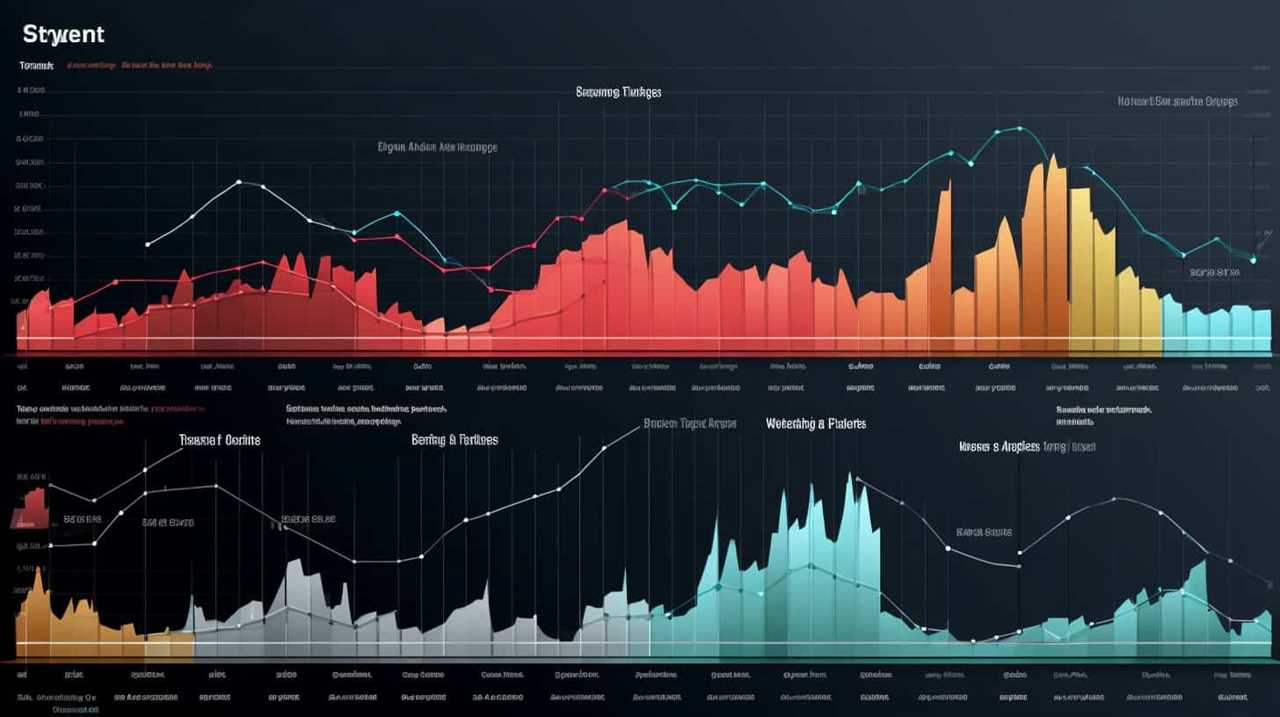Advertising
Seo Features for Website

Did you know over 90% of online experiences start with a search engine? That’s why implementing strong SEO tactics on your website is crucial, as they significantly contribute to drawing in visitors and boosting your web visibility.
In this article, we’ll explore the key elements of SEO that can significantly improve your website’s performance. From optimizing meta tags and keywords to ensuring mobile responsiveness and user-friendly navigation, we’ll guide you through the essential steps to achieve SEO mastery and attract more visitors to your site.
Key Takeaways
- Meta tag optimization and keyword research are crucial for improving website visibility and search engine rankings.
- Building high-quality backlinks from reputable sources enhances website authority and visibility.
- Site speed and mobile responsiveness are important factors for user satisfaction and search engine rankings.
- A simplified URL structure with relevant keywords and the use of XML sitemaps contribute to optimal website performance and SEO.
Meta Tags
Meta tags are essential elements of a website’s HTML code that provide information about the webpage to search engines. When it comes to meta tag optimization and following meta tag best practices, it’s crucial to understand their impact on SEO.
By strategically optimizing meta tags, websites can improve their search engine rankings and increase visibility to potential users. Meta tag optimization involves carefully crafting meta titles and descriptions that accurately represent the content of each webpage while incorporating relevant keywords.

It’s important to keep the meta tags concise, informative, and user-friendly, as search engines use this information to determine the relevance and quality of a webpage. Effective meta tag optimization sets the foundation for successful keyword optimization, which we’ll discuss in the next section.
Keyword Optimization
Keywords are an essential aspect of SEO and play a significant role in improving website visibility. By strategically incorporating relevant keywords into your website content, meta tags, and headings, you can increase your chances of ranking higher in search engine results.
To maximize the effectiveness of keyword optimization, it’s crucial to follow SEO best practices and conduct thorough keyword research to identify the most relevant and high-performing keywords for your website.
Importance of Keywords
How can we optimize our website’s content to ensure maximum visibility and relevance in search engine results?

One crucial aspect of achieving this is through effective keyword optimization. By conducting thorough keyword research, we can identify the specific terms and phrases that our target audience is using to search for information online. Incorporating these keywords strategically in our website’s content can help improve its visibility and ranking in search engine results.
On-page optimization plays a significant role in this process as well. Here are four key considerations for keyword optimization:
- Keyword placement: Ensure that keywords are strategically placed in the title tag, meta description, headings, and throughout the content.
- Keyword density: Maintain a balanced keyword density that’s neither too high nor too low.
- Long-tail keywords: Target long-tail keywords to capture more specific search queries.
- Keyword variations: Utilize synonyms and related terms to diversify keyword usage and cater to different search intents.
SEO Best Practices
To optimize our website’s content and improve its visibility and relevance in search engine results, we need to follow SEO best practices for keyword optimization. One important aspect of keyword optimization is the use of meta descriptions.
A meta description is a brief summary of a webpage’s content that appears in search engine results. It should be concise, keyword-rich, and enticing to users, as it can greatly impact click-through rates.

Additionally, backlink building plays a crucial role in SEO. Backlinks are links from other websites that point to your site. They’re considered as votes of confidence and can boost your site’s authority and visibility in search results.
It’s important to focus on building high-quality backlinks from reputable sources to enhance your website’s SEO performance.
Site Speed
Improving website speed is crucial for optimizing SEO performance. A slow-loading website not only frustrates users but also impacts search engine rankings.
To ensure your website is delivering optimal performance, consider the following site speed optimization strategies:

- Compress and optimize images: Use compression tools to reduce image file sizes without sacrificing quality. This helps improve page load times.
- Minify CSS and JavaScript files: Remove unnecessary characters, whitespace, and comments from code to reduce file sizes and improve load times.
- Enable browser caching: By enabling browser caching, you allow visitors to store certain elements of your website on their local device, reducing the need for repeated downloads.
- Use a content delivery network (CDN): A CDN stores your website’s files on multiple servers around the world, delivering content to users from the server closest to them, resulting in faster load times.
Mobile Responsiveness
Continuing the optimization strategies, we prioritize enhancing mobile responsiveness for improved SEO performance.
Mobile usability and responsive design are crucial factors in today’s digital landscape. With the increasing number of mobile users, it’s essential to ensure that your website is accessible and user-friendly across different devices.
A responsive design allows your website to adapt and adjust its layout based on the screen size and resolution. This ensures that your content is easily readable and navigable, which improves the overall user experience.
Mobile responsiveness isn’t only important for user satisfaction but also for search engine rankings. Search engines like Google prioritize mobile-friendly websites in their search results, making it a crucial aspect of SEO.

URL Structure
As we delve into the optimization strategies for our website’s SEO features, let’s explore the importance of a well-structured URL. URL optimization plays a crucial role in improving your website’s visibility and search engine rankings.
Here are some URL structure best practices to consider:
- Keep it concise and descriptive: Use relevant keywords that accurately describe the content of the page.
- Use hyphens instead of underscores or spaces: Hyphens are more search engine-friendly and help improve readability.
- Avoid using unnecessary parameters: Keep the URL clean and remove any unnecessary query strings or parameters.
- Use lowercase letters: Using lowercase letters in your URLs ensures consistency and avoids any confusion.
By following these URL structure best practices, you can enhance your website’s SEO performance and make it easier for search engines to understand and rank your content.
Now, let’s move on to the next topic: xml sitemap.

XML Sitemap
Let’s talk about the importance of XML Sitemap for your website’s SEO.
An XML Sitemap is a file that lists all the URLs on your website, helping search engines understand its structure and content.
By providing a clear roadmap, a sitemap improves crawlability, indexing, and user experience.
Additionally, there are various sitemap generation tools available that make creating and updating your sitemap a breeze.

Importance of XML Sitemap
We understand the importance of XML Sitemap in optimizing our website’s SEO.
Here are four reasons why XML Sitemap is crucial for our website:
- Enhanced crawlability: XML Sitemaps provide search engines with a roadmap of our website’s structure, ensuring that all pages are easily discovered and indexed.
- Faster indexing: By submitting an XML Sitemap to search engines, we can expedite the indexing process, allowing our new content to appear in search results more quickly.
- Improved user experience: XML Sitemaps help create user-friendly navigation by organizing our website’s pages and providing users with a clear and logical structure.
- Regular updates and prioritization: XML Sitemaps can be automatically generated using sitemap generation tools, ensuring that search engines are promptly notified of any changes or additions to our website.
SEO Benefits of Sitemap
Continuing the discussion from the previous subtopic on the importance of XML Sitemap, incorporating a sitemap into our website’s SEO strategy offers several benefits.
Sitemap benefits include improved crawling and indexing by search engines, which means that our website’s pages will be discovered and ranked more efficiently.

With a sitemap, we can also provide additional metadata about our web pages, such as when they were last updated, their priority, and their relation to other pages on our site. This helps search engines understand our website’s structure and content better, leading to better search engine rankings.
Furthermore, sitemaps can also help with website navigation, making it easier for users to find the information they’re looking for.
Sitemap Generation Tools
To optimize our website’s SEO, we can utilize various sitemap generation tools, specifically those that generate XML sitemaps. These tools play a crucial role in ensuring that search engines can easily crawl and index our website’s pages.
Here are four reasons why using sitemap generation tools is beneficial:

- Improved visibility: XML sitemaps provide search engines with a comprehensive map of our website’s structure, helping them understand the content and hierarchy of our pages.
- Faster indexing: By submitting our XML sitemap to search engines, we can expedite the process of getting our webpages indexed, leading to quicker visibility in search results.
- Better crawling: Sitemap generation tools ensure that all our webpages are included in the sitemap and easily accessible to search engine spiders, allowing for more thorough crawling of our site.
- Easy updates: These tools automatically generate updated sitemaps whenever we add or remove pages, making it simple to keep our sitemap current and ensure our website is properly indexed.
User-Friendly Navigation
One crucial aspect of creating an effective website with SEO features is implementing a clear and intuitive navigation system that allows users to easily access the desired information. Improving accessibility and enhancing user experience are key goals when it comes to designing user-friendly navigation.
By organizing content in a logical and hierarchical manner, visitors can quickly find what they’re looking for without getting frustrated. This not only improves user satisfaction but also encourages them to spend more time on your website, which can positively impact your SEO rankings.
Additionally, utilizing descriptive and keyword-rich navigation labels can help search engines understand the structure and content of your website better.
Now that we’ve discussed the importance of user-friendly navigation, let’s move on to the next section about high-quality content.

High-Quality Content
After discussing the importance of user-friendly navigation, we now delve into the significance of high-quality content for effective SEO features on a website.
High-quality content is essential for attracting and engaging users, as well as improving search engine rankings. Here are four key reasons why high-quality content is crucial for SEO:
- Relevance: High-quality content is relevant to the target audience, answering their questions and providing valuable information.
- Authority: Well-written content establishes the website as an authoritative source, gaining trust and credibility among users and search engines.
- Engagement: Effective storytelling through high-quality content captivates users, keeping them on the website longer and reducing bounce rates.
- Shareability: Compelling content encourages users to share it on social media platforms, increasing website visibility and driving more organic traffic.
Image Optimization
Image optimization is an essential aspect of SEO for websites. It enhances user experience and improves search engine rankings. One key aspect of image optimization is image compression. It reduces the file size of images without compromising their quality. Compressing images allows websites to load faster, improving overall user experience.
Another important element of image optimization is alt text optimization. Alt text is a description added to an image that helps search engines understand what the image is about. Optimizing alt text with relevant keywords can improve search engine visibility and drive organic traffic to the website.

By implementing image compression and optimizing alt text, websites can improve their SEO performance and provide a better user experience.
Now, let’s move on to the next section about social media integration.
Social Media Integration
Let’s talk about the benefits of social media integration and the best strategies to implement it.
By integrating social media into your website, you can increase your online visibility, reach a larger audience, and drive more traffic to your site.

Some effective integration strategies include adding social sharing buttons, embedding social media feeds, and incorporating social login options.
Benefits of Integration
When it comes to optimizing your website for SEO, one of the key benefits is the integration of social media. By incorporating social media into your website, you can leverage the power of popular platforms to enhance your online presence and drive more traffic to your site.
Here are four benefits of integrating social media:
- Increased visibility: Social media platforms provide a vast audience for your content, allowing you to reach a larger number of potential customers.
- Better engagement: Social media integration allows for easy sharing and interaction, fostering engagement with your audience and increasing brand awareness.
- Improved analytics: Social media platforms offer robust analytics tools that provide valuable insights into your audience’s behavior, allowing you to optimize your strategies for better results.
- Conversion rate optimization: By integrating social media, you can guide visitors from social platforms to your website, increasing the chances of converting them into paying customers.
Integrating social media into your SEO strategy can greatly benefit your website by enhancing visibility, engagement, analytics, and ultimately, conversion rates.

Best Integration Strategies
To continue our discussion on the benefits of integrating social media into your SEO strategy, let’s explore the best strategies for incorporating social media into your website. Social media integration is a crucial aspect of website design in today’s digital landscape. By seamlessly integrating your social media platforms into your website, you can enhance user engagement, increase brand visibility, and drive more traffic to your site. Here are some effective integration strategies to consider:
| Integration Strategy | Description | Benefits |
|---|---|---|
| Social Sharing Buttons | Place social sharing buttons on your website to make it easy for visitors to share your content on their social media profiles. | Increased content reach and visibility |
| Social Media Feeds | Display real-time social media feeds on your website to showcase your social media activity and encourage users to follow your profiles. | Improved social proof and engagement |
| Social Media Login | Allow users to log in to your website using their social media accounts, simplifying the registration process and enhancing user experience. | Streamlined user registration and increased conversions |
| Social Media Widgets | Embed social media widgets on your website to display your social media profiles, followers count, and recent posts. | Increased brand credibility and social engagement |
| Social Media Integration in Content | Integrate social media elements, such as embedded tweets or Instagram photos, within your content to make it more interactive and shareable. | Enhanced user experience and increased content virality |
Frequently Asked Questions
How Do Meta Tags Affect Website SEO and Rankings?
Meta tags play a crucial role in website SEO and rankings. They provide important information to search engines about the content of a webpage. Optimizing meta tags can improve website visibility and boost SEO efforts.
What Are the Best Practices for Keyword Optimization in Website Content?
When it comes to keyword optimization in website content, our best practices involve conducting thorough keyword research and then strategically incorporating those keywords into our content for maximum SEO impact.
How Does Site Speed Impact User Experience and Seo?
Site speed greatly affects both SEO and user experience. Slow-loading websites frustrate users and negatively impact search engine rankings. Optimizing website performance is crucial for a successful online presence.

What Are the Key Factors to Consider for Ensuring Mobile Responsiveness in a Website?
When considering mobile responsiveness in a website, key factors to consider include mobile design and website layout. These factors are crucial for ensuring a seamless user experience across different devices.
How Does URL Structure Affect Search Engine Rankings and Website Visibility?
URL structure greatly impacts search engine rankings and website visibility. Short, keyword-rich URLs are more effective for SEO. Our audience seeks mastery in website optimization, so we’ll discuss the importance of URL length and keyword usage.
Conclusion
In the vast wilderness of the internet, our website is like a well-equipped campsite, ready to welcome and guide visitors on their journey.
With meta tags and keyword optimization, we ensure search engines can easily find us.

Our site speed and mobile responsiveness guarantee a smooth and enjoyable experience for all.
The carefully crafted URL structure and user-friendly navigation make exploration effortless.
And with high-quality content, image optimization, and social media integration, we provide a warm and inviting atmosphere.
Join us and embark on a delightful online adventure.

Advertising
How Do I Pass an Seo Interview

The famous quote ‘knowledge is power’ is widely recognized. This rings especially true when it comes to excelling in an SEO interview.
We know you’re eager to liberate yourself from the anxiety of job hunting and impress potential employers with your SEO expertise. That’s why we’re here to share essential concepts, effective strategies, and expert tips to help you nail that interview and secure your dream SEO job.
Let’s dive in and unleash your SEO potential!
Key Takeaways
- Understanding SEO best practices, core components, and the importance of SEO tools and analytics
- Advanced keyword analysis, understanding keyword intent, and targeting high-potential keywords
- Content creation, conducting SEO audits, and optimizing factors like page load speed and mobile-friendliness
- Mastering technical SEO by focusing on website architecture, site visibility, and mobile optimization
Essential SEO Concepts
In this section, we’ll explore the fundamental principles and core components of SEO. Understanding SEO best practices is essential for achieving success in digital marketing.

SEO tools and analytics play a crucial role in optimizing our website’s performance and improving our online visibility. By utilizing these tools, we can analyze important data such as keyword rankings, website traffic, and user behavior. This valuable information allows us to make data-driven decisions and continuously improve our SEO strategies.
Implementing SEO best practices and leveraging SEO tools and analytics is key to staying ahead in the competitive online landscape.
Now that we’ve covered the essential concepts of SEO, let’s dive into the next section, which will focus on effective keyword research strategies.
Effective Keyword Research Strategies
Now let’s explore effective keyword research strategies to further enhance our SEO efforts and drive targeted organic traffic to our website.

One of the key strategies is advanced keyword analysis. This involves going beyond basic keyword research and delving deeper into understanding the intent behind the keywords. By analyzing search volume, competition, and relevance, we can identify high-potential keywords that will bring in the most relevant traffic.
Additionally, long tail keyword targeting is another powerful strategy. Long tail keywords are longer and more specific phrases that have less competition and higher conversion rates. By targeting these niche keywords, we can attract highly qualified visitors who are more likely to convert into customers.
On-Page Optimization Techniques
To continue our discussion on effective SEO strategies, let’s dive into the realm of on-page optimization techniques.
On-page optimization plays a crucial role in improving a website’s visibility and ranking in search engine results pages (SERPs). One key aspect of on-page optimization is content creation. By creating high-quality, relevant, and engaging content, you can attract more organic traffic and keep visitors on your site longer.

Additionally, conducting an SEO audit is essential to identify areas for improvement on your website. This includes analyzing factors such as page load speed, mobile-friendliness, URL structure, and metadata.
Mastering Technical SEO
Continuing our exploration of effective SEO strategies, let’s delve into the realm of mastering technical SEO with a focus on optimizing website performance and structure.
A well-designed website architecture is crucial for search engines to understand and crawl your site effectively. It involves organizing your website’s pages, URLs, and navigation in a logical and user-friendly manner. This can improve your site’s visibility and accessibility, ultimately boosting its search rankings.
Additionally, mobile optimization is essential in today’s digital landscape, as more and more users access the internet through their smartphones. Ensuring that your website is responsive and mobile-friendly won’t only enhance the user experience but also align with search engines’ preferences, leading to higher rankings.

Nailing SEO Interview Questions
Let’s tackle SEO interview questions head-on to ensure we nail them with confidence and expertise.
When preparing for an SEO interview, it’s important to have a solid understanding of the industry and its best practices. One of the most common SEO interview mistakes isn’t being well-prepared. To avoid this, you should familiarize yourself with the latest SEO trends, algorithms, and tools.
Additionally, it’s crucial to have a clear understanding of the core concepts of SEO, such as keyword research, on-page optimization, and link building.
To further enhance your chances of success, practice answering common SEO interview questions and have specific examples ready to demonstrate your skills and knowledge.

Frequently Asked Questions
What Are Some Common Challenges Faced in Implementing SEO Strategies and How Can They Be Overcome?
Implementing SEO strategies can be challenging due to technical issues and competition. However, we can overcome these obstacles by conducting thorough competitor analysis and addressing any technical issues promptly.
How Can Social Media Platforms Be Integrated Into an SEO Strategy?
Social media platforms can be integrated into an SEO strategy by leveraging social media engagement to drive traffic and improve search engine rankings. Content marketing strategies can be used to create and promote valuable content on social media platforms, boosting visibility and engagement.
What Are Some Effective Ways to Measure the Success of an SEO Campaign?
To measure the success of an SEO campaign, we track key performance indicators such as organic traffic, keyword rankings, and conversion rates. These metrics give us valuable insights into the effectiveness of our strategies.
Can You Provide Some Tips for Optimizing Websites for Voice Search?
When optimizing websites for voice search, key considerations include understanding natural language, using long-tail keywords, and optimizing for featured snippets. Voice search optimization strategies involve creating conversational content and improving site speed for a seamless user experience.

How Important Is Link Building in SEO and What Are Some Best Practices for Building High-Quality Backlinks?
Link building is a crucial aspect of SEO. It helps improve our website’s visibility and rankings. Anchor text plays a significant role in link building, and acquiring natural backlinks through quality content and outreach strategies is essential.
Conclusion
In conclusion, mastering the art of SEO is like navigating a vast ocean of information. By understanding essential concepts, conducting effective keyword research, implementing on-page optimization techniques, and mastering technical SEO, you can set sail toward success.
Just like a skilled sailor, your ability to navigate this ever-changing landscape will determine your success in an SEO interview. So, prepare yourself, equip your knowledge, and confidently set sail into the world of SEO.
Advertising
How Do I Get Free Seo Keywords

Are you tired of spending a significant amount of money on SEO keywords? Your search ends here! Discover the methods to acquire SEO keywords without any cost.
In this article, we’ll share the secrets to finding valuable keywords without breaking the bank. By utilizing tools like Google’s Keyword Planner and analyzing competitor keywords, you can optimize your website for search engines without spending a dime.
Get ready to unlock the power of free SEO keywords and set your website free!
Key Takeaways
- Importance of conducting keyword research and utilizing keyword research tools for website optimization
- Benefits of using long-tail keywords for free SEO optimization, including attracting a more relevant audience and improving search engine rankings
- The value of leveraging user-generated content for keyword research, such as maximizing social media engagement and analyzing customer reviews for keyword insights
- The strategic advantage of analyzing competitor keywords and incorporating competitor keyword insights into our SEO strategy, including using tools for competitive analysis and analyzing keyword gaps.
Understanding the Importance of SEO Keywords
Understanding the importance of SEO keywords involves identifying the most relevant and effective terms for optimizing website visibility and attracting organic traffic.

One crucial aspect of SEO optimization is understanding keyword density. Keyword density refers to the percentage of times a specific keyword appears on a web page compared to the total number of words. It’s essential to strike the right balance between using keywords enough to boost search engine rankings, but not so much that it appears unnatural or spammy.
Another factor that plays a significant role in boosting SEO rankings is the use of meta tags. Meta tags are snippets of HTML code that provide information about a web page’s content to search engines. They include title tags, meta descriptions, and meta keywords.
By optimizing these meta tags with relevant keywords, you can improve your website’s visibility and attract more organic traffic.
Understanding keyword density and utilizing meta tags effectively are key elements in achieving successful SEO optimization.

Utilizing Google’s Keyword Planner Tool
To further optimize website visibility and attract organic traffic, we can utilize Google’s Keyword Planner Tool. This tool is a powerful resource that enables us to conduct keyword research and find relevant keywords for our website.
By identifying the right keywords, we can improve our website’s ranking on search engine results pages and attract more visitors.
In addition to Google’s Keyword Planner Tool, there are other alternative keyword research tools available that can provide valuable insights. These tools can help us find keywords that might be overlooked by competitors, giving us a competitive edge.
Once we’ve identified our target keywords, it’s important to maximize keyword density in our website content. This means incorporating the keywords naturally and strategically throughout our website to increase its visibility and relevance to search engines.

Exploring Long-Tail Keywords for Free SEO Optimization
After utilizing Google’s Keyword Planner Tool, we can now delve into exploring long-tail keywords for free SEO optimization. Long-tail keywords are longer and more specific keyword phrases that are often less competitive but highly targeted. They can help you attract a more relevant audience and improve your search engine rankings.
When conducting keyword research, it’s important to consider the intent of your target audience. By understanding their needs and preferences, you can identify long-tail keywords that align with their search queries. Here’s a table highlighting some keyword research techniques and long-tail keyword strategies:
| Keyword Research Techniques | Long-Tail Keyword Strategies |
|---|---|
| Analyzing competitor keywords | Using question-based keywords |
| Exploring related searches | Incorporating location-specific keywords |
| Conducting customer surveys | Targeting niche-specific keywords |
Leveraging User-Generated Content for Keyword Research
We can further enhance our keyword research by leveraging user-generated content. One effective way to do this is by maximizing social media engagement for keyword discovery.
By actively engaging with our audience on social media platforms, we can gather valuable insights into the words and phrases they use when discussing our products or services.

Additionally, harnessing the power of customer reviews can provide us with valuable keyword insights. By analyzing the language used in these reviews, we can identify recurring keywords that are relevant to our business.
This user-generated content can give us a deeper understanding of how our target audience thinks and speaks about our offerings. By incorporating these insights into our keyword research, we can optimize our SEO strategy to better meet our audience’s needs.
Now, let’s dive into the next section about analyzing competitor keywords for free SEO insights.
Analyzing Competitor Keywords for Free SEO Insights
Continuing our exploration of keyword research, let’s now delve into the world of analyzing competitor keywords to gain valuable SEO insights. When it comes to optimizing our website for search engines, understanding what keywords our competitors are ranking for can provide us with a strategic advantage.

Here are four steps to help us analyze competitor keywords effectively:
- Identify top ranking competitor keywords: Start by identifying our main competitors in the industry and then analyze their websites to identify the keywords they’re ranking for.
- Use SEO keyword research tools for competitive analysis: Utilize tools like SEMrush or Ahrefs to gather data on our competitors’ keyword rankings, search volume, and competition level.
- Analyze keyword gaps: Compare our own keyword rankings to those of our competitors to identify any keyword gaps we can take advantage of.
- Study competitor content: Analyze our competitors’ content to understand how they’re using keywords effectively and incorporate those strategies into our own content.
Frequently Asked Questions
What Are Some Common Mistakes to Avoid When Conducting Keyword Research for SEO Optimization?
When conducting keyword research for SEO optimization, it’s important to avoid common mistakes. By using effective long tail keyword identification techniques, we can ensure accurate and targeted results that will boost our website’s visibility.
How Can I Identify the Most Effective Long-Tail Keywords for My Website?
To identify the most effective long-tail keywords for your website, consider best practices for using long tail keywords in content marketing. Additionally, track the performance of long tail keywords in SEO campaigns to optimize your strategy.
Are There Any Alternative Keyword Research Tools Besides Google’s Keyword Planner?
There are alternative keyword research tools besides Google’s Keyword Planner. We can explore the best practices for using them and optimize SEO keywords for voice search. Let’s liberate our SEO strategies!

How Can I Optimize User-Generated Content to Target Specific SEO Keywords?
To optimize user-generated content for targeting specific SEO keywords, we can follow a few steps. First, research and identify the keywords relevant to your content. Then, incorporate these keywords naturally into the user-generated content to enhance its SEO performance.
What Are Some Strategies for Staying Updated on Competitor Keywords in Order to Gain an Edge in Seo?
To gain an edge in SEO, we stay updated on competitor keywords through thorough competitor analysis. This allows us to develop an effective SEO strategy that liberates us from relying solely on free SEO keywords.
Conclusion
In the vast world of SEO, finding free keywords can feel like searching for buried treasure. But fear not! By understanding the importance of keywords, utilizing tools like Google’s Keyword Planner, exploring long-tail keywords, leveraging user-generated content, and analyzing competitor keywords, you can unlock the hidden gems that will boost your website’s visibility.
So, put on your SEO detective hat and start uncovering those valuable keywords, turning your website into a shining star in the vast online universe.

Happy hunting!
Advertising
How Can I Practice Seo for Free

Are you tired of shelling out a lot of money on SEO tools and services? Well, we have some exciting news for you! In this article, we will share our tips on how to implement SEO without spending a dime.
Yes, you heard that right – free! Get ready to unlock the secrets of keyword research, on-page optimization, content creation, building high-quality backlinks, and monitoring SEO performance.
Say goodbye to expensive tools and hello to liberation! Let’s dive in and revolutionize your SEO game, together.
Key Takeaways
- Conduct thorough keyword research using free keyword research tools to identify popular and relevant topics.
- Incorporate relevant keywords naturally throughout the content to optimize website visibility in search results.
- Implement on-page optimization techniques such as optimizing meta tags, page titles, and on-page elements like headings and keyword usage.
- Build high-quality backlinks through guest posting on niche websites and sharing website content on social bookmarking sites to increase visibility and improve search engine rankings.
Keyword Research
When practicing SEO for free, we begin by conducting keyword research to identify the most relevant and valuable terms to target for website optimization. Competitor analysis plays a vital role in this process. By analyzing our competitors’ websites, we can gain insights into the keywords they’re targeting and identify potential gaps or opportunities.

Additionally, we focus on long tail keywords, which are more specific and have lower competition. These keywords allow us to attract highly targeted traffic and increase our chances of ranking higher in search engine results.
By incorporating competitor analysis and long tail keywords into our keyword research strategy, we can optimize our website effectively and attract the right audience.
With this foundation in place, we can now move on to the next step: on-page optimization.
On-Page Optimization
To optimize our website for search engines without spending any money, we focus on improving our on-page elements. This includes optimizing our meta tags and page titles. Meta tags provide information about the content of a webpage to search engines, while page titles help search engines understand the topic of the page. By using relevant keywords in our meta tags and page titles, we can improve our website’s visibility in search results.

Another important aspect of on-page optimization is image optimization. This involves optimizing the images on our website to make them more search engine-friendly. We can achieve this by using descriptive filenames, alt tags, and optimizing the image size and format. By implementing these image optimization techniques, we can enhance our website’s overall SEO performance and attract more organic traffic.
Content Creation and Optimization
For content creation and optimization, we prioritize the creation and optimization of high-quality and relevant content on our website. This is essential for effective content promotion and to ensure that our website ranks well in search engine results.
To achieve this, we follow a few key strategies:
- Conducting thorough keyword research to identify popular and relevant topics to write about.
- Creating compelling, informative, and engaging content that appeals to our target audience.
- Incorporating relevant keywords naturally throughout the content to improve its visibility to search engines.
- Using SEO friendly website design techniques, such as optimizing page load speed and ensuring mobile responsiveness.
- Implementing proper on-page optimization techniques, such as meta tags and header tags, to enhance the visibility of our content.
Building High-Quality Backlinks
As we delve into the topic of practicing SEO for free, one crucial aspect to explore is the process of building high-quality backlinks. Backlinks are links from other websites to your own, and they play a significant role in improving your website’s search engine ranking.

One effective way to build high-quality backlinks is through guest posting. By writing valuable content for other websites in your niche, you can include a link back to your own site. This not only helps you gain exposure to a new audience but also establishes your website as a reliable source of information.
Another method is through social bookmarking, where you share your website’s content on social bookmarking sites. This helps increase visibility and attract more visitors to your site.
Moving forward, let’s now explore the next step in practicing SEO for free – monitoring and analyzing SEO performance.
Monitoring and Analyzing SEO Performance
Now, let’s delve into how we can effectively monitor and analyze the performance of our SEO efforts. To ensure that our SEO strategies are yielding the desired results, it’s crucial to regularly monitor and analyze our performance.

Here are some key steps to help us in this process:
- Implement competitor analysis: By studying our competitors’ SEO strategies, we can identify areas for improvement and stay ahead in the game.
- Utilize local SEO strategies: Targeting local keywords and optimizing our website for local search can help us attract relevant and high-quality traffic.
- Track keyword rankings: Monitoring our keyword rankings allows us to evaluate the effectiveness of our SEO efforts and make necessary adjustments.
- Analyze website traffic: By analyzing website traffic, we can identify which sources are driving the most visitors to our site and optimize accordingly.
- Monitor conversion rates: Tracking conversion rates helps us measure the success of our SEO campaigns in terms of generating leads or sales.
Frequently Asked Questions
What Are Some Common Mistakes to Avoid When Conducting Keyword Research?
When conducting keyword research, we need to be aware of common mistakes. By understanding these mistakes, we can avoid them and improve the effectiveness of our SEO strategies.
Are There Any Specific Strategies or Techniques to Optimize Images for On-Page Seo?
When it comes to optimizing images for on-page SEO, we have found that compressing images without losing quality and using descriptive alt tags are two effective techniques. These best practices can greatly improve your website’s SEO.
How Can I Ensure That My Content Is Engaging and Relevant to Both Search Engines and Users?
Creating captivating meta descriptions and improving user experience are key to ensuring that our content is engaging and relevant to both search engines and users. It’s essential for better SEO rankings.

What Are Some Effective Ways to Acquire High-Quality Backlinks Organically?
To acquire high-quality backlinks organically, we recommend guest blogging and influencer collaborations. These strategies allow us to build relationships and gain valuable exposure, boosting our website’s credibility and visibility in search engines.
Is There a Recommended Frequency for Monitoring and Analyzing SEO Performance?
There is a recommended frequency for reporting and analyzing SEO performance. Regular analysis allows us to stay on top of our SEO efforts, identify areas for improvement, and make data-driven decisions.
Conclusion
In conclusion, practicing SEO for free isn’t only possible but also crucial for improving website visibility and driving organic traffic.
By focusing on keyword research, optimizing on-page elements, creating high-quality content, and building strong backlinks, you can greatly enhance your SEO performance.

So, don’t miss out on this golden opportunity to skyrocket your website’s rankings and dominate the search engine results.
Start implementing these strategies today, and watch your online presence soar like a rocket in the digital universe!
-

 Holistic SEO3 months ago
Holistic SEO3 months agoHolistic Local SEO Tactics for Small Businesses
-

 Holistic SEO3 months ago
Holistic SEO3 months agoKeyword Research (SEO) for Tattoo Artists
-

 Holistic SEO3 months ago
Holistic SEO3 months agoHow to Establish Dominance in SEO through Topical Authority
-

 Learning Center3 months ago
Learning Center3 months ago52 Niches with Good Crossover Potential Explored
-

 Learning Center3 months ago
Learning Center3 months agoThe Future of SEO: Leveraging the Google Search Generative Experience
-

 Holistic SEO3 months ago
Holistic SEO3 months agoHolistic SEO Food Blogger
-

 Keyword Research3 months ago
Keyword Research3 months agoMastering SEO: How to Analyze Keyword Results and Find Easy Keywords
-

 Technical SEO3 months ago
Technical SEO3 months agoUnlock Your Site’s Potential with a Comprehensive Website Audit



















